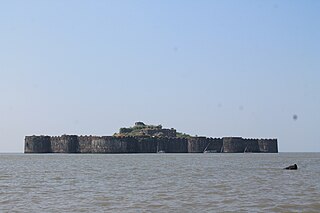
The Deccan sultanates is a historiographical term referring to five late medieval to early modern Indian kingdoms on the Deccan Plateau between the Krishna River and the Vindhya Range that were created from the disintegration of the Bahmani Sultanate and ruled by Muslim dynasties: namely Ahmadnagar, Berar, Bidar, Bijapur, and Golconda. The five sultanates owed their existence to the declaration of independence of Ahmadnagar in 1490, which was followed by Bijapur and Berar in the same year. Bidar became independent in c. 1492, and Golconda in 1512.

The Sultanate of Bijapur was an early modern kingdom in the western Deccan and South India, ruled by the Adil Shahi dynasty. Bijapur had been a taraf (province) of the Bahmani Kingdom prior to its independence in 1490 and before the kingdom's political decline in the last quarter of the 15th century. It was one of the Deccan sultanates, the collective name of the kingdom's five successor states. The Sultanate of Bijapur was one of the most powerful states on the Indian Subcontinent at its peak, second to the Mughal Empire which conquered it in 1686 under Aurangzeb.

Shahaji Bhonsale was a 17th century Indian military leader who served the Ahmadnagar Sultanate, the Bijapur Sultanate, and the Mughal Empire at various points in his career. As a member of the Bhonsle dynasty, Shahaji inherited the Pune and Supe jagirs (fiefs) from his father Maloji, who previously served the Ahmadnagar Sultanate. During the Mughal invasion of the Deccan, Shahaji joined the Mughal forces and served under Emperor Shah Jahan for a short period. After being deprived of his jagirs, he defected to the Bijapur Sultanate in 1632 and regained control over Pune and Supe. In 1638, he received the jagir of Bangalore after Bijapur's invasion of Kempe Gowda III's territories. Afterwards, he became the chief general of Bijapur and oversaw its expansion.

Malik Ambar was a military leader and statesman who served as the Peshwa of the Ahmadnagar Sultanate and its de facto ruler from 1600 until his death in 1626.

Mohammed Adil Shah was the seventh sultan of Bijapur, ascending the throne in 1627. During his reign, he assisted the Mughals with their campaigns against the Ahmednagar Sultanate and signed a peace treaty with them in 1636. He died in 1656 and was buried in the Gol Gumbaz.

Ali Adil Shah II was the 8th Sultan of Bijapur. He succeeded to the throne of Bijapur through the efforts of the Prime Minister Khan Muhammad and the Queen, Badi Sahiba, sister of Qutb Shah of Golkonda on the death of Mohammed Adil Shah of Bijapur on 4 November 1656.

The Sultanate of Ahmednagar was a late medieval Indian Marathi kingdom located in the northwestern Deccan, between the sultanates of Gujarat and Bijapur, ruled by the Nizam Shahi dynasty. It was established when Malik Ahmed, the Bahmani governor of Junnar, after defeating the Bahmani army led by general Jhangir Khan on 28 May 1490, declared independence and established the Ahmadnagar Sultanate.
Burhan Nizam Shah I was ruler of the Ahmednagar Sultanate, in Central India. He ascended the throne on the death of his father Ahmad Nizam Shah I in 1508 or 1510 when he was seven years old. He died in 1553 and was succeeded by Hussain Nizam Shah I.

Veer Shivaji is an Indian historical drama series that aired on Colors TV from 2 September 2011 to 25 May 2012. The show focuses on the life of Shivaji, the 17th century founder of the Maratha Empire.

The siege of Bijapur began in March 1685 and ended in September 1686 with a Mughal victory. The siege began when Aurangzeb dispatched his son, Muhammad Azam Shah, with a force of nearly 50,000 men to capture Bijapur Fort and defeat Sikandar Adil Shah, the then Sultan of Bijapur, who refused to be a vassal of the Mughal Empire. The siege of Bijapur was one of the longest military engagements of the Mughals, lasting more than 15 months until Aurangzeb personally arrived to organise a victory.
Maloji Bhonsale was a Maratha chief (Sardar) who served the Ahmadnagar Sultanate. He was the father of Shahaji Raje and the grandfather of Chattrapati Shivaji Maharaj, the founder of the Maratha Empire.
Shahar Banu Begum was Empress consort of the Mughal Empire from 14 March 1707 to 8 June 1707 as the third wife of Emperor Muhammad Azam Shah. She is popularly known by the titles Padishah Bibi and Padshah Begum.

The Deccan sultanates were five early modern kingdoms, namely Bijapur, Golkonda, Ahmadnagar, Bidar, and Berar, which ruled the Deccan Plateau for part of the 15th, and the majority of the 16th–17th centuries. Their architecture was a regional variant of Indo-Islamic architecture, and influenced by the styles of the Delhi Sultanate and later Mughal architecture, but sometimes also influenced from Persia and Central Asia. Hindu temple architecture in the same areas had very different styles.

"Bhaskargad Fort, alternatively known as Basgad Fort, is a hill fort situated within the Nashik district of Maharashtra, India. Part of the Trimbak hill range, it lies in proximity to Harihar Fort. Located approximately 48 kilometers away from Igatpuri, Bhaskargad Fort is recognized as a favored site for activities such as trekking and hiking."
The Battle of Bhatvadi was fought in 1624, near modern Bhatodi Pargaon village in Maharashtra, India. The Ahmadnagar army led by Malik Ambar defeated a combined Mughal-Bijapur force led by the Bijapuri general Mullah Muhammad Lari.

Khunza Humayun Begum also known as Kurja Sultana, Khanzada Humayun Sultana and Khunzah Humayun, was the regent of the Ahmadnagar Sultanate between 1565 and 1571, during the minority of her son sultan Murtaza Nizam Shah I.
the Raid of Ahmednagar took place in 1657, when the Marathas led by Shivaji penetrated as far as Ahmednagar in hopes of asseting Bijapur Sultan, the raid, however, was repulsed.

The siege of Daulatabad (1633) was a conflict between the Mughal Empire and the Ahmadnagar Sultanate, wherein the fort-city of Daulatabad was besieged by a Mughal force for several months and successfully captured. The Bijapur Sultanate also participated in the conflict against the Mughals, sending a large army to the aid of the fort's garrison. The conflict took place after several Mughal victories securing other minor forts in Ahmadnagar control, but was distinguished by the political significance of Daulatabad to the Ahmadnagar Sultanate. This event marked Mughal victory in the ongoing war between the Mughals and the Ahmadnagar Sultanate; it ended the Nizam Shahi dynasty and concluded the Sultanate, marking another step in the Mughal advance over the Deccan region. The victory did not fully quell resistance to Mughal authority in the Western Deccan; a year later, Maratha commander Shahji Bhonsle attempted a bid for power using a puppet ruler of the Nizam Shahi house.
The siege of Parenda (1634) was a 17th-century military conflict between the Mughal Empire and the Adil Shahi dynasty of the Bijapur Sultanate over Parenda Fort, wherein Mughal forces besieged the Adil Shahi fort for four months. The siege took place during the reigns of Mughal emperor Shah Jahan and Bijapur Sultan Muhammad Adil Shah. It was the second Mughal siege of the fort following a failed attempt in 1631, and was part of a string of Mughal military campaigns in the Western Deccan. The siege was led by Mughal general Mahabat Khan, governor of the Deccan, though the young prince Shah Shuja was its nominal commander. The siege lasted four months and was unsuccessful, with the fort remaining in Adil Shahi control.
Hussain Nizam Shah III was the 12th Sultan of Ahmadnagar Sultanate under the regency of Fath Khan and Shahaji. It was during his reign the second phase of extinction of Ahmadnagar Sultanate began. He was imprisoned by Shah Jahan in the Gwalior Fort after Mahabat Khan's successful conquest of Dautlatabad. He was succeeded by Murtaza Nizam Shah III.












